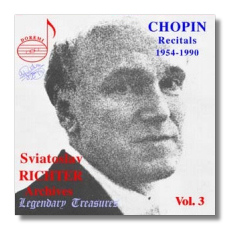
The Internet's Premier Classical Music Source
Related Links
- Chopin Reviews
- Latest Reviews
- More Reviews
-
By Composer
-
Collections
DVD & Blu-ray
Books
Concert Reviews
Articles/Interviews
Software
Audio
Search Amazon
Recommended Links
Site News
 CD Review
CD Review
Frédéric Chopin

Sviatoslav Richter Archives, Volume 2
- Scherzo #1 in B minor, Op. 20
- Scherzo #2 in B Flat minor, Op. 31
- Scherzo #3 in C Sharp minor, Op. 39
- Scherzo #4 in E Major, Op. 54
- Polonaise-Fantaisie in A Flat Major, Op. 61
- Barcarolle, Op. 60
- Waltzes, Op. 34 #1 - 3
- Mazurka in C Sharp minor, Op. 63 #3
- Mazurka in C Major, Op. 67 #3
- Mazurka in F Major, Op. 68 #3
- Mazurka in A minor, Op. posth
Sviatoslav Richter, piano
DOREMI DHR-7724, total time 78:52


Sviatoslav Richter Archives, Volume 3
- 6 Études from Op. 10: #1, 6, 10, 11, 12, and 4
- Polonaise-Fantaisie in A Flat Major, Op. 61
- Scherzo #4 in E Major, Op. 54
- Waltz in F Major, Op. 34 #3
- Waltz in D Flat minor, Op. 70 #3
- Étude in F Sharp minor, Op. 25 #7
- 10 Préludes from Op. 28: #8, 9, 10, 11, 4, 5, 6, 7, 19, and 17
- Trois nouvelles études
- Impromptu in F-sharp, Op. 36
- Impromptu in G Flat Major, Op. 51
Sviatoslav Richter, piano
DOREMI DHR-7738, total time 79:49
Recorded at Carnegie Hall, New York, April 15, 1967 (Scherzos); in Warsaw, November 10, 1954 (Polonaise); in Salzburg, August 26, 1977 (Barcarolle and Waltzes); and in Helsinki, August 25, 1976 (Mazurkas); Royal Festival Hall, London, January 27, 1963 (Études, Op. 10); in Helsinki, August 25, 1976 (Polonaise, Scherzo, Waltzes, Étude); in Warsaw, November 10, 1954 (Préludes), and in La Roque d'Antheron, France, January 31, 1990 (Nouvelles études, Impromptus). Reissues produced by Jacob Harnoy.
The second and third discs in the series entitled "Sviatoslav Richter Archives" from DOREMI are now available. Both feature the music of Chopin, and most of the performances are new to CD.
It is a bold move to open the set with the Scherzos from Carnegie Hall. This really shows Richter at his best and most exciting. Ten years before the great studio and festival recordings from Munich and Salzburg, Richter brought a special magic to these performances. His Carnegie Hall appearances always displayed a high intensity and willingness to take risks that allowed him to surpass everything else he did. The playing is very fast, even rushed at times, and it is certainly not note-perfect as it would be in the later recordings, but the electricity and sense of occasion more than make up for a few slips.
The sound quality here and in the balance of the two discs is somewhat dull, probably as a result of processing to remove noise. The source here is apparently a tape made by an audience member.
From Warsaw thirteen years earlier come two very different performances. The Polonaise-Fantaisie is competent but unmemorable. The excerpts from the Op. 28 Préludes are a completely different story. This is an amazing performance, both for the brilliant virtuosity and for the shifting moods. For example, number 8 is played very fast and with perfect control over the musical shape; number 9, with gravity; number 10, very delicately, with wonderful pianissimo arpeggios; number 11, warmly; and number 4 is hesitant, gentle, almost fearful. There is much more effective contrast here than in his later versions. Here is the essential Richter.
There is audible distortion in the material from Warsaw and the sound is a little more grainy and muffled than New York. While not high fidelity, it is certainly listenable.
Material recorded in Salzburg gives us a chance to compare the sound of the DOREMI with releases from Music & Arts (CD-1019) and Orfeo (C491981B). All three include the Barcarolle and the Op. 34 Waltzes, and all sound different. Orfeo has the clear advantage, as they had access to the official Salzburg Festival tapes, and their version does sound better and more realistic. Unfortunately they did not release all of the recital. It is complete only on Music & Arts, which has good audio quality but is somewhat noisier than the others. (And the Barcarolle on the Music & Arts disc only gets off to a bad start technically, as though the tape started just a little late.)
There is more overlap between DOREMI and Music & Arts (CD-1020), as both document the August 1976 Helsinki recital. Music & Arts gives us as much of the recital as will fit on one disc and DOREMI supplies the missing Chopin Mazurkas. These moody, melancholic dances are played with a bit of an edge here; they are dreamy and a little sad.
The second DOREMI disc also contains much that had never been released on LP or CD. The six Études from London, 1963, are apparently all encores, as there is applause after each one. These are Richter's earliest recordings of these pieces (not counting those on film) and the most interesting. Especially good in this set is the Op. 10 number 12, its rushing passagework invested with a Lisztian grandeur. Number 4 also is very exciting and fast, a risky headlong rush into the piece.
For contrast, compare the Nouvelles études recorded in France in 1990. These little-known pieces do not rise to the technical or imaginative level of the 24 in Opp. 10 and 25, and the performance exhibits grace and sensitivity rather than daring. In this case the choice of repertoire is telling. In his last years, as Richter's technique declined, he found a different kind of beauty in simpler scores.
Copyright © 1999, Paul Geffen


















